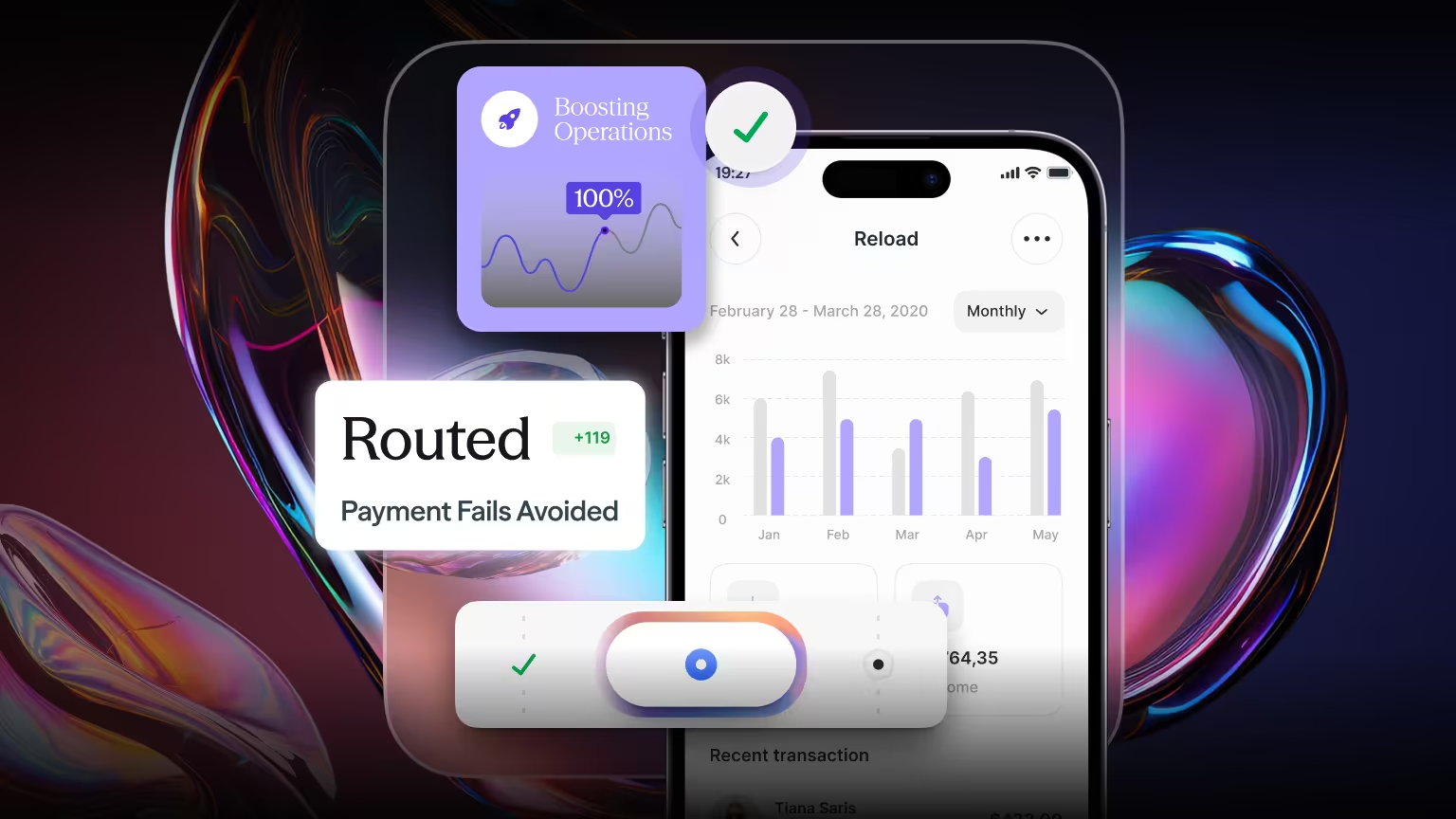Common Payment Failures & How Orchestration Prevents Them
Learn how orchestration fixes payment failures, improves approval rates, and protects your revenue.

In today’s hyperconnected digital economy, seamless payments are expected but far from guaranteed. Many businesses still experience payment failure rates as high as 10 - 13%, losing significant revenue and customer trust in the process. According to Payments Dive, failure during checkout is one of the most overlooked yet damaging friction points in digital commerce.
So what causes these failures? And more importantly, how can payment orchestration help prevent them?
Why Payments Fail in the First Place
The most immediate cause is card declines. They can occur due to expired cards, insufficient funds, incorrect CVV entries or generic “Do Not Honour” responses from the issuing bank. But the problem doesn’t stop there.
Many failures stem from a single payment service provider (PSP) dependency. If your only provider experiences downtime or latency, the transaction fails. Similarly, if your PSP doesn’t support local payment methods or preferred currencies in certain regions, your global customers are likely to abandon their carts altogether.
Another growing issue is false declines. According to Riskified, merchants lost $443 billion in 2021 alone due to transactions incorrectly flagged as fraudulent. These “false positives” are often caused by rigid fraud tools and can be more damaging than fraud itself. In fact, Payments Cards & Mobile reports that 30% of falsely declined customers never return.
Then there’s the silent killer: technical errors.
Payment API failures, integration timeouts or misconfigured checkout flows can block legitimate payments with no visible warning, leading to confused customers and lost conversions.
The Hidden Cost of Failed Payments
Every failed transaction represents more than a missed sale; it’s a breakdown in trust, a hit to revenue and a strain on internal resources. For many businesses, resolving payment issues drains valuable time and manpower, with teams often forced to chase down incomplete transactions and field frustrated support queries.
In subscription-based models, the consequences multiply. When recurring payments fail, whether from expired cards or insufficient funds, customers may churn without ever intending to. These silent cancellations erode long-term revenue and chip away at customer lifetime value.
The damage doesn't stop at your balance sheet. Failed payments create friction in the user journey. Would you return to a site that declined your card without a reason or resolution? Many customers won’t. A single failed transaction can be enough to lose a buyer forever, especially if there’s no recovery mechanism in place.
What Is Payment Orchestration?
Payment orchestration is a modern solution that addresses all of these issues at once. Rather than being tied to a single PSP or fraud tool, orchestration introduces a smart layer between your frontend and the various payment services behind the scenes.
An orchestration platform connects multiple acquirers, gateways, APMs (alternative payment methods), and fraud tools,allowing you to route each transaction intelligently. If one PSP is down or underperforming, another can instantly take over. If a transaction fails for a soft reason (like temporary network issues), it can automatically retry using a different path.
This approach eliminates single points of failure and gives merchants the flexibility to scale payments globally, optimise performance by region, and reduce failed transactions by 10–15%.
How Orchestration Prevents Payment Failures
Intelligent Routing Built for Success
One of the most powerful features of payment orchestration is smart transaction routing. Instead of sending every payment through a single provider, an orchestration layer evaluates each transaction in real time, based on location, card network, issuer data and historical approval rates. This means payments are sent to the acquirer most likely to approve them.
If one PSP experiences downtime or lag, the system instantly redirects the transaction to a secondary provider. This dynamic failover capability ensures that technical outages don’t translate into lost sales. For the end customer, checkout remains seamless, even if something breaks behind the scenes.
Automated Decline Recovery
Not all payment declines are permanent. Many are temporary or due to recoverable errors, like insufficient funds at the moment of payment or authentication timeouts. A well-configured orchestration engine can detect these soft declines and automatically retry the transaction, using another provider, updated parameters or different authentication paths.
This retry process is invisible to the customer and can significantly boost overall payment success rates. Rather than forcing users to try again manually, orchestration takes care of it in the background, minimising friction and maximising conversion.
Support for Local and Alternative Payment Methods
As global commerce expands, customers expect to use familiar, region-specific payment methods. That might mean iDEAL in the Netherlands, BLIK in Poland or bank transfers in the UK. Orchestration makes it easy to offer these without rebuilding your tech stack or managing dozens of separate integrations.
By aggregating multiple PSPs and APMs into a unified flow, orchestration lets you adapt to local payment preferences across different markets. This not only improves acceptance rates but also builds trust at checkout, especially for first-time buyers.
Smarter Fraud Management with Fewer False Positives
Fraud prevention is essential, but overly aggressive filters can backfire. Orchestration platforms allow merchants to integrate multiple fraud tools and customise rules to fit their business model. Rather than applying a blanket rule to all transactions, you can route riskier ones through extra checks, while fast-tracking trusted customers.
This approach dramatically reduces false declines, where legitimate users are mistakenly blocked, and helps balance security with conversion. When fraud prevention is modular and intelligent, everyone wins.
Real-Time Insights and Performance Visibility
Traditional payment setups often leave merchants in the dark. But with orchestration, you get a real-time view of your entire payments ecosystem. Dashboards highlight success rates, failure patterns, PSP performance, fraud activity and retry results, all in one place.
This visibility empowers teams to act quickly when issues arise and continuously refine their setup. That’s not just convenience but a competitive edge.
Real-World Impact: Scaling Through Orchestration
Take the example of a UK-based SaaS company offering monthly plans. They were losing revenue due to failed card renewals, regional limitations, and escalating support tickets. After implementing payment orchestration, the business connected with multiple acquirers and introduced local APMs in key European markets.
They also set up automated retries for subscription billing failures and introduced custom fraud flows for high-risk transactions. Within the first six months, payment success rates improved significantly. The churn rate from involuntary declines dropped by nearly 10%, and support requests related to billing errors fell by over a third.
More importantly, the business was able to expand confidently into new markets, knowing its payments infrastructure could scale with demand. Orchestration didn’t just fix failures, it enabled growth.
What Can Merchants Do Next?
If your decline rate exceeds 8% or if you are relying on a single PSP for global payments, now is the time to rethink your architecture.
Start by auditing your current failure rates and gateway performance. Then, assess whether your existing stack supports local APMs, dynamic routing, and real-time retries. If it doesn’t, payment orchestration might be the missing link.
Would you keep trusting a system that lets 1 in 10 transactions fail silently?
Reduce Friction, Reclaim Revenue with finera.
Failed payments are more than a technical issue, they are a threat to revenue, customer satisfaction, and brand credibility. Yet many businesses treat them as inevitable. With payment orchestration, that no longer has to be the case.
From smart routing and automatic retries to fraud optimisation and local payment method integration, orchestration platforms give merchants the tools to succeed in a fragmented and fast-changing payments landscape.
If you want to stop losing customers at checkout, reduce operational overhead and increase authorisation rates globally, it’s time to move beyond patchwork solutions.
finera.’s intelligent payment orchestration empowers businesses to reduce failure rates, optimise payments and deliver frictionless customer experiences across every market and method.
Talk with our team today and see how smarter payments start with orchestration.
This article on payment methods is for informational and educational purposes only.
- Not Professional Advice: The content provided does not constitute financial, legal, tax, or professional advice. Always consult with a qualified professional before making financial decisions.
- No Liability: The authors, contributors, and the publisher assume no liability for any loss, damage, or consequence whatsoever, whether direct or indirect, resulting from your reliance on or use of the information contained herein.
- Third-Party Risk: The discussion of specific payment services, platforms, or institutions is for illustration only. We do not endorse or guarantee the performance, security, or policies of any third-party service mentioned. Use all third-party services at your own risk.
- No Warranty: We make no warranty regarding the accuracy, completeness, or suitability of the information, which may become outdated over time.
Frequently Asked Questions

Still Have Questions?
Let’s Find the Right Solution for You
Stay Connected with Us!
Follow us on social media to stay up to date with the latest news, updates, and exclusive insights!






.avif)
